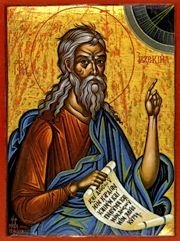Instead of that other garbage... see this film!

While we are on the topic of films in this post-Oscar week, this documentary of a Carthusian monastery seems fascinating... and it is getting fine reviews (even from the likes of the NY Times, no less!). Read the NY Times review (I especially like his conclusion--highlighted in bold):
MOVIE REVIEW 'INTO GREAT SILENCE'
Lives Lived at a Monk’s Pace, Allowing Time for the Spirit to Flourish
By A. O. SCOTT
Published: February 28, 2007
Published: February 28, 2007
The Carthusian monks who are the subjects of Philip Gröning’s documentary “Into Great Silence” do not, as the film’s title suggests, have a great deal to say. Living in a light-filled stone charterhouse (as the order’s monasteries are called) in a picturesque valley in the French Alps, they bind themselves to a vow not of literal silence but of extreme reticence. They pray and sing aloud, alone and together, and once a week the elders take an outdoor stroll during which some chatting is permitted.
Mr. Gröning’s cameras (one of them operated by the pioneering digital videographer Anthony Dod Mantle) observe the brothers from afar, or unobtrusively within their cells, a discreet approach that occasionally gives way to head-on portraiture.
Only one monk, elderly and blind, speaks directly to the camera. Appearing near the end of the film, he muses on the nature of his vocation and the texture of his religious devotion. Past and present are human categories, he says, but “for God, there is no past, only present.” Viewed from this perspective — from the standpoint of eternity — “Into Great Silence,” with a running time of 162 minutes, is absurdly short.
Mr. Gröning, a German filmmaker, waited 16 years for permission to document the Carthusians, and this too seems like a trivial interval. The order was founded by St. Bruno of Cologne in 1084, and it appears that not much has changed in the lives of its adherents since then. A few concessions to modernity are visible: electric lights, a computer for keeping the books, and oranges and bananas in the middle of winter. But the rhythm of work, prayer and reflection —the attitude described as “joyful penitence” — flows in a cycle that feels not so much ancient as timeless.
And the film’s achievement is to capture, within a brief, elliptical span, this slow, delicate rhythm. “Into Great Silence” is not about the Carthusians in the conventional sense that documentaries are about their subjects. It offers no background on the history or theology of the order, nor any information about the biographies of individual monks. Though we do witness the initiation and adaptation of two novices, we learn nothing about their previous lives or their reasons for joining.
The psychology and philosophy of asceticism are not Mr. Gröning’s concern. He is after something more elusive and, from an aesthetic as well as an intellectual point of view, more valuable: a point of contact with the spiritual content of intense religious commitment.
He finds it by means of a visual style and an editing scheme that match the feeling and structure of the days and seasons as they pass through the charterhouse. Snow gives way to greenery, early morning light cycles around to darkness, and the viewer witnesses ordinary moments that add up to a persuasive representation of grace.
Not the thing itself — Mr. Gröning is not so vain as to suppose that a movie can provide a religious experience — but a preliminary understanding of its shape and weight. The sensual beauty of the images is part of this, but the film has more than lovely alpine vistas and arresting compositions of light and shade. Like the monks themselves, it is both humble and exalted.
And, in its way, eloquent. The idea of removing yourself entirely from the world is a radical one, and Mr. Gröning approaches it with fascination and a measure of awe. At first, as your mind adjusts to the film’s contemplative pace, you may experience impatience. Where is the story? Who are these people? But you surrender to “Into Great Silence” as you would to a piece of music, noting the repetitions and variations, encountering surprises just when you think you’ve figured out the pattern. By the end, what you have learned is impossible to sum up, but your sense of the world is nonetheless perceptibly altered.
I hesitate, given the early date and the project’s modesty, to call “Into Great Silence” one of the best films of the year. I prefer to think of it as the antidote to all of the others.
INTO GREAT SILENCE
Opens today in Manhattan.
Written (in English and Latin, with English subtitles), produced, directed and edited by Philip Gröning; director of photography, Mr. Gröning; released by Zeitgeist Films. At the Film Forum, 209 West Houston Street, west of Avenue of the Americas, South Village. Running time: 162 minutes. This film is not rated.
Link to original article: http://movies2.nytimes.com/2007/02/28/
movies/28sile.html?ex=1173330000&en=50687
bbf16e40a01&ei=5070&emc=eta1
movies/28sile.html?ex=1173330000&en=50687
bbf16e40a01&ei=5070&emc=eta1
LINKS:
The official website of the Carthusian order:
A Wikipedia article on the Carthusian order:
Who was their founder St. Bruno?
Labels: film, religious life, spirituality, vocations


<< Home